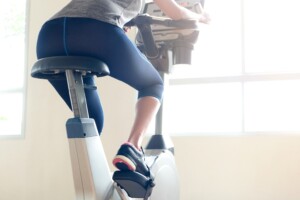
Never underestimate the power of stationary bike workouts for melting off excess fat in your stomach, thighs or anywhere else — as long as you do it anaerobically.
Because pedaling a stationary bike is so easy, requiring no impact and no balance, you may think that it’s impossible to perform a wickedly punishing routine on this simple piece of exercise equipment.
Don’t let the simplicity of the stationary bike fool you; this tool is a potent weapon in the war on stubborn body fat.
Pedaling the bike in the “aerobic zone” has its limitations; namely, you won’t burn as much fat as you will if pedaling in the anaerobic zone (also referred to as the “cardio” or “athletic training” zone on some machines’ consoles).
Traditionally, the stationary bike has proven very useful for a comfortable, inviting warm-up for a grueling weight workout, or a hard-paced run on the treadmill. It’s also popular for warm-downs.
But don’t stop there. Include the stationary bike as a tool for igniting fat loss.

©Lorra Garrick
Take a break from the treadmill, elliptical or outdoor running. Shock your body with something different for a change.

Shutterstock/Seasontime
A shocked body will use up more stored fat to deal with the shock—the shock of something entirely new that it is not acquainted with.
The anaerobic threshold varies from one person to the next. This is that point at which your body’s energy system shifts gears: from aerobic to anaerobic.
The more fit you are, the higher will be your anaerobic threshold. You must find out where yours is with cycling.
This is done as follows: Picture a number scale: 1 is how you feel when lying on a hammock, and 10 is how you’d feel if you just tried to outrun a train.
For ultimate fat loss, you want an exertion output that makes you feel at level 9-10. Because this is very near or at maximal intensity, it cannot be sustained for very long.
In other words, how hard must you pedal a stationary bike before you’re ready to fall off of it after only 20 or 30 seconds?
It’s easy to think you’re ready to fall off the bike if you’ve been pedaling with gusto for 20 minutes nonstop.
But when I say “ready to fall off,” I mean it: You’re so spent that you cannot pedal one revolution past 20-30 seconds.
Your thighs are wasted. You can’t talk.
The settings to achieve this kind of exertion, depending on your cardio fitness level, might be a level 12 on a bike that goes up to 12 “levels,” which indicate resistance of pedal crank.
This is a sturdy pedal resistance, but it must be combined with high RPMs to completely tax you in under half a minute. The RPMs in this case might be 100—sustained for an entire 30 seconds.
Try it. If you can go beyond 30 seconds, then after two minutes of easy pedaling at very light resistance (level 1-3), see if you can sustain an RPM of 130 at level 12.
Keep searching for that RPM speed that, if carried out at level 12, leaves you with no energy to go beyond half a minute.
Now, some bikes have up to 20 levels. In that case, a level 12 on these bikes is easier than a level 12 on a bike that has only 12 levels. There are many makes and models of stationary bikes out there.
For many people, it will be impossible to pedal 100 RPMs at level 18 on some models.
Don’t get confused by all these numbers here; focus more on the concept:
At at least 100 RPMs, figure out the pedal resistance (“level,” which is usually indicated by an “L” on the bike’s console), that turns you to toast within 30 seconds.
If you’re pedaling longer than 30 seconds, you begin going into a pacing mode.
This workout’s brief bursts of high-powered pedaling are supposed to be “sprints,” to maximize fat-burning.
They alternate with two minutes of lenient, gentle pedaling (70 RPMs at very light pedal resistance).
- Warm up for 10 minutes with easy pedaling progressing to moderate pedaling.
- Then begin this high intensity interval training by introducing your first 30-second interval—but make it a perceived exertion of 7 or 8 on that 1-10 scale mentioned prior.
- The next interval can be an 8.
- Make the next a 9.
- After that, you are warmed up for all-out sprints on the stationary bike.
Don’t get caught up with counting how many sprint intervals you do. Instead, when the time lapse hits 40-45 minutes, start winding down by pedaling at medium intensity for several minutes, and then light pedaling for a few more minutes.
50 Minutes Tops
The entire time you’re on the bike, including warm-up and warm-down, should not exceed 50 minutes.
This kind of anaerobic cycling can be done twice per week when you are trying to cut up or really thin out your body fat layer, while hanging onto mass.
A third cardio session per week should be done at low intensity and for long duration.
 Lorra Garrick is a former personal trainer certified through the American Council on Exercise. At Bally Total Fitness she trained women and men of all ages for fat loss, muscle building, fitness and improved health.
Lorra Garrick is a former personal trainer certified through the American Council on Exercise. At Bally Total Fitness she trained women and men of all ages for fat loss, muscle building, fitness and improved health.
.
























